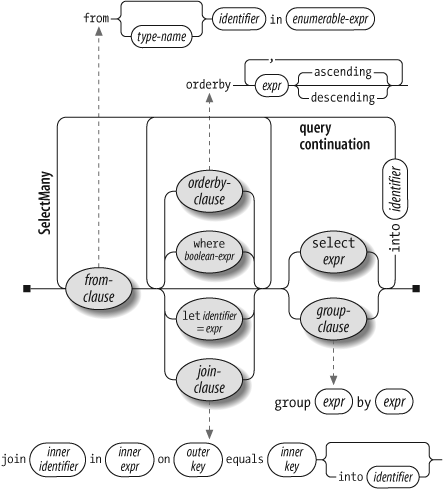Comprehension Queries
C# provides a syntactic shortcut for writing LINQ queries, called query comprehension syntax, or simply query syntax.
In the preceding section, we wrote a query to extract strings containing the letter a, sorted by length, and converted to uppercase. Here’s the same query in comprehension syntax:
string[] names = { "Tom","Dick","Harry","Mary","Jay" };
IEnumerable<string> query =
from n in names
where n.Contains ("a") // Filter elements
orderby n.Length // Sort elements
select n.ToUpper( ); // Project each element
foreach (string name in query)
Console.Write (name + "/");
// RESULT: JAY/MARY/HARRY/A comprehension query always starts with a from clause and ends with either a select or group clause. The from clause declares an iteration
variable (in this case, n), which you can think of as traversing the
input collection—rather like foreach.
Figure 1-2 illustrates the complete
syntax.

Figure 1-2. Query comprehension syntax
The compiler processes comprehension queries by translating them to lambda
syntax. It does this in a fairly mechanical fashion—much like it
translates foreach statements into
calls to GetEnumerator and MoveNext. This means that anything you can
write in comprehension syntax you can also write in lambda syntax. The
compiler translates our example query into the following:
IEnumerable<string> query = names
.Where (n => n.Contains ("a"))
.OrderBy (n ...Get LINQ Pocket Reference now with the O’Reilly learning platform.
O’Reilly members experience books, live events, courses curated by job role, and more from O’Reilly and nearly 200 top publishers.

